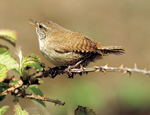Little wren tops the charts
Losers outnumber winners, is the message from our annual bird stocktake


Losers outnumber winners is the succinct verdict on the 13th annual ‘stock-take' of Britain's birds. Overall, the State of the UK's Birds 2012 report, compiled largely from volunteer surveys, points to an alarming loss of 44 million birds since 1966, which equates to a pair of nesting birds per minute. ‘The long-term picture is sobering,' comments a British Trust for Ornithology official.
* Subscribe to Country Life and get our Ipad edition at no extra cost
The feisty wren continues to be the UK's most numerous bird (8.6 million pairs), although numbers have dropped by about 835 a day since 2000, and the chaffinch has increased, by some 150 birds a day to 6.2 million. The decline of the house sparrow (5.3 million) continues to baffle ornithologists and it's now among the 52 species red-listed in the UK (of most conservation concern). Some of these species, such as the bittern, nightjar and corncrake are showing recovery on a local basis, but two sea ducks-the velvet scoter and the longtailed duck-could become globally extinct and nearly every sea bird is in trouble.
Turtle-dove numbers have dropped dramatically to 14,000 pairs, yet the collared-dove population has exploded to nearly one million; the greatspotted woodpecker stands at 140,000 pairs, but its lesser-spotted cousin is a miserable 1,500; there are about 50,000 pairs of tawny owls but only 4,000 of barn owls. Unsurprisingly, magpies, crows, feral pigeons and buzzards are categorised as being ‘of least concern.
* Follow Country Life magazine on Twitter
Sign up for the Country Life Newsletter
Exquisite houses, the beauty of Nature, and how to get the most from your life, straight to your inbox.
Country Life is unlike any other magazine: the only glossy weekly on the newsstand and the only magazine that has been guest-edited by HRH The King not once, but twice. It is a celebration of modern rural life and all its diverse joys and pleasures — that was first published in Queen Victoria's Diamond Jubilee year. Our eclectic mixture of witty and informative content — from the most up-to-date property news and commentary and a coveted glimpse inside some of the UK's best houses and gardens, to gardening, the arts and interior design, written by experts in their field — still cannot be found in print or online, anywhere else.
-
 Rodel House: The Georgian marvel in the heart of the Outer Hebrides
Rodel House: The Georgian marvel in the heart of the Outer HebridesAn improving landlord in the Outer Hebrides created a remote Georgian house that has just undergone a stylish, but unpretentious remodelling, as Mary Miers reports. Photographs by Paul Highnam for Country Life.
By Mary Miers
-
 380 acres and 90 bedrooms on the £25m private island being sold by one of Britain's top music producers
380 acres and 90 bedrooms on the £25m private island being sold by one of Britain's top music producersStormzy, Rihanna and the Rolling Stones are just a part of the story at Osea Island, a dot on the map in the seas off Essex.
By Lotte Brundle